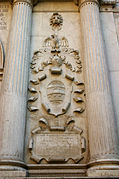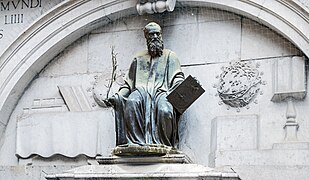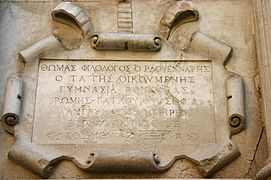The Chiesa di San Giuliano (St Julian), commonly called San Zulian in the Venetian dialect, is a church on the Merceria, the main shopping street of Venice, in the parish of San Salvador, Venice, Italy.
Originally built in the 9th century, it underwent a number of reconstructions, including probably after the 1105 fire of the neighborhood. The façade was constructed in 1553-1554 by Jacopo Sansovino, and completed after his death in 1570 by Alessandro Vittoria.
The flattened classical temple façade was paid for by the scholar Tommaso Rangone, whose bronze seated portrait appears above the door. In his hands, the physician Rangone holds sarsaparilla and guaiacum, two plants which he used to treat syphilis and yellow fever. The reliefs also depict a map of the world as was known at his death. As befitting his broad-ranging interests in classical texts, the flanking inscriptions are in Latin (center), Greek (right) and Hebrew (left) text.
The interior was also designed by Sansovino, and the church consecrated in 1580.

Jacopo d'Antonio Sansovino was an Italian Renaissance sculptor and architect, best known for his works around the Piazza San Marco in Venice. These are crucial works in the history of Venetian Renaissance architecture. Andrea Palladio, in the Preface to his Quattro Libri was of the opinion that Sansovino's Biblioteca Marciana was the best building erected since Antiquity. Giorgio Vasari uniquely printed his Vita of Sansovino separately.

The Church of San Zaccaria is a 15th-century former monastic church in central Venice, Italy. It is a large edifice, located in the Campo San Zaccaria, just off the waterfront to the southeast of Piazza San Marco and St Mark's Basilica. It is dedicated to St. Zechariah, the father of John the Baptist.
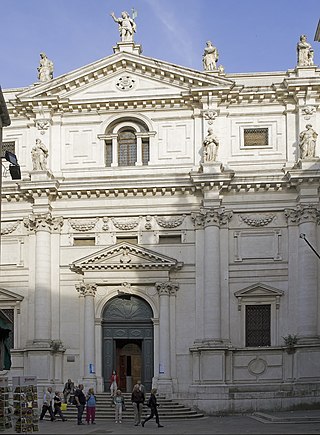
The Chiesa di San Salvatore is a church in Venice, northern Italy. Known in Venetian as San Salvador, is located on the Campo San Salvador, along the Merceria, the main shopping street of Venice. The church was first consecrated in 1177 by Pope Alexander III shortly after his reconciliation with Emperor Frederick Barbarossa at nearby San Marco. The present church, however, was begun in around 1508 by Giorgio Spavento and continued after his death the following year by Tullio Lombardo, Vincenzo Scamozzi and possibly Jacopo Sansovino. They built a large hall church, formed from three Greek crosses placed end to end. Each has a dome with a lantern to let light into the cavernous interior. The facade was added in 1663 by Giuseppe Sardi.

The Basilica di Santa Maria Gloriosa dei Frari, commonly abbreviated to the Frari, is a church located in the Campo dei Frari at the heart of the San Polo district of Venice, Italy. It is the largest church in the city and it has the status of a minor basilica. The church is dedicated to the Assumption of Mary.

The Chiesa di San Giacomo dall'Orio is a church located in the sestiere (quarter) of Santa Croce in Venice, northern Italy.

San Giorgio Maggiore is a 16th-century Benedictine church on the island of the same name in Venice, northern Italy, designed by Andrea Palladio, and built between 1566 and 1610. The church is a basilica in the classical Renaissance style and its brilliant white marble gleams above the blue water of the lagoon opposite the Piazzetta di San Marco and forms the focal point of the view from every part of the Riva degli Schiavoni.

The Chiesa dell'Angelo Raffaele is a church in Venice, northern Italy, located in the Dorsoduro sestiere. San Raffaele Arcangelo church is one of the only two churches in Venice that are possible to walk all around. It is located in Dorsoduro neighbourhood, close to San Basilio water bus stop.
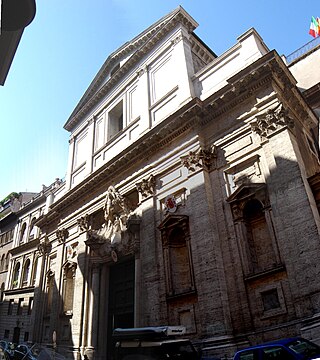
The Spanish National Church of Santiago and Montserrat, known as Church of Holy Mary in Monserrat of the Spaniards is a Roman Catholic titulus church and National Church in Rome of Spain, dedicated to the Virgin of Montserrat. It is located in the Rione Regola, at the intersection of alleyway of Via della Barchetta and the narrow Via di Monserrato, with the facade on the latter street, about three blocks northwest of the Palazzo Farnese.

Santa Maria del Rosario, commonly known as I Gesuati, is an 18th-century Dominican church in the Sestiere of Dorsoduro, on the Giudecca canal in Venice, northern Italy. The classical style building has a well-lit interior and is exceptional in preserving its original layout and Rococo decoration intact. The church and almost all its sculpture and paintings were created within a thirty-year period: construction began in 1725, the church was consecrated in 1743, and the last sculptural decoration was in place by 1755.

San Francesco della Vigna is a Roman Catholic church in the Sestiere of Castello in Venice, northern Italy.
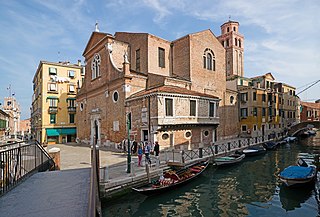
San Martino is a Renaissance Roman Catholic church in the sestiere of Castello of Venice, northern Italy.
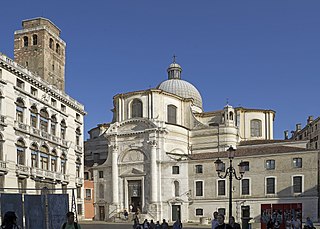
San Geremia is a church in Venice, northern Italy, located in the sestiere of Cannaregio. The apse of the church faces the Grand Canal (Venice), between the Palazzo Labia and the Palazzo Flangini. The edifice is popular as the seat of the cult of Saint Lucy of Syracuse, whose remains are housed inside.
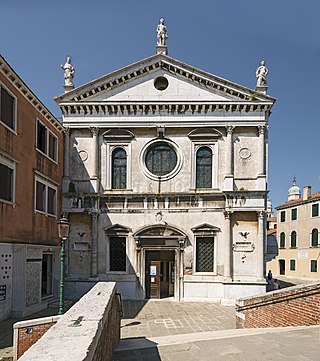
The Chiesa di San Sebastiano is a 16th-century Roman Catholic church located in the Dorsoduro sestiere of the Italian city of Venice. The church houses a cycle of paintings by the artist Paolo Veronese, as well as paintings by Tintoretto and Titian. The church is a member of the Chorus Association of Venetian churches. It stands on the Campo di San Sebastiano by the Rio di San Basilio, close to the Giudecca Canal. It is one of the five votive churches in Venice, each one built after the passing of a plague through the city. Following construction, the church was dedicated to a saint associated with the disease; in this case St. Sebastian.

The church of Santa Maria Assunta, known as I Gesuiti, is a religious building in Venice, Italy. It is located in the sestiere of Cannaregio, in Campo dei Gesuiti, not far from the Fondamenta Nuove.

The Scuola di San Giorgio degli Schiavoni in Venice, northern Italy, was one of the city's confraternities, a scuola piccola located in the sestiere (neighborhood) of Castello, Venice. Its building has been preserved.

San Felice is a church in Venice, northern Italy, located in the sestiere (district) of Cannaregio. It faces the eponymous campo (square), across the Strada Nova.

The church of Santa Maria delle Grazie in Brescia is located on at the west end of Via Elia Capriolo, where it intersects with the Via delle Grazie. Built in the 16th century and remodeled in the 17th century, it still retains much of its artwork by major regional artists, including one of its three canvases by Moretto. The other two are now held at the Pinacoteca Tosio Martinengo. The interior is richly decorated in Baroque fashion. Adjacent to the church is the Sanctuary of Santa Maria delle Grazie, a neo-gothic work.

Sant'Agostino is a Roman Catholic church, originally founded in the 13th-century but refurbished in the following centuries, located on Corso XI Settembre in the historic center of Pesaro, region of Marche, Italy.
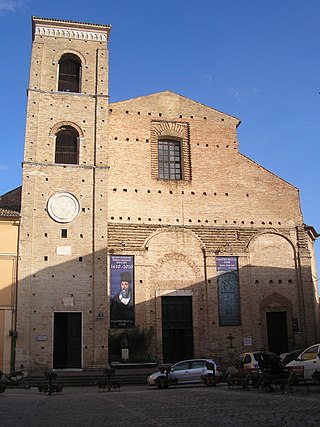
Macerata Cathedral is a Renaissance-style, Roman Catholic cathedral dedicated to the St Julian in the town of Macerata, province of Macerata, region of Marche, Italy.

San Geminiano was a Roman Catholic church located in Piazza San Marco in Venice, Italy, dedicated to Saint Geminianus. It is believed to have been founded by the Byzantines in the 6th century AD and it was destroyed and rebuilt several times over subsequent centuries. The last reconstruction began in 1505 to designs of the architect Cristoforo da Legname, and it was completed by Jacopo Sansovino in 1557. This church was a significant example of Venetian Renaissance architecture, and it was well-known for being ornate and richly decorated. The building was demolished in 1807 in order to make way for the Napoleonic wing of the Procuratie, and many of the artworks it contained were distributed among other churches and museums.





